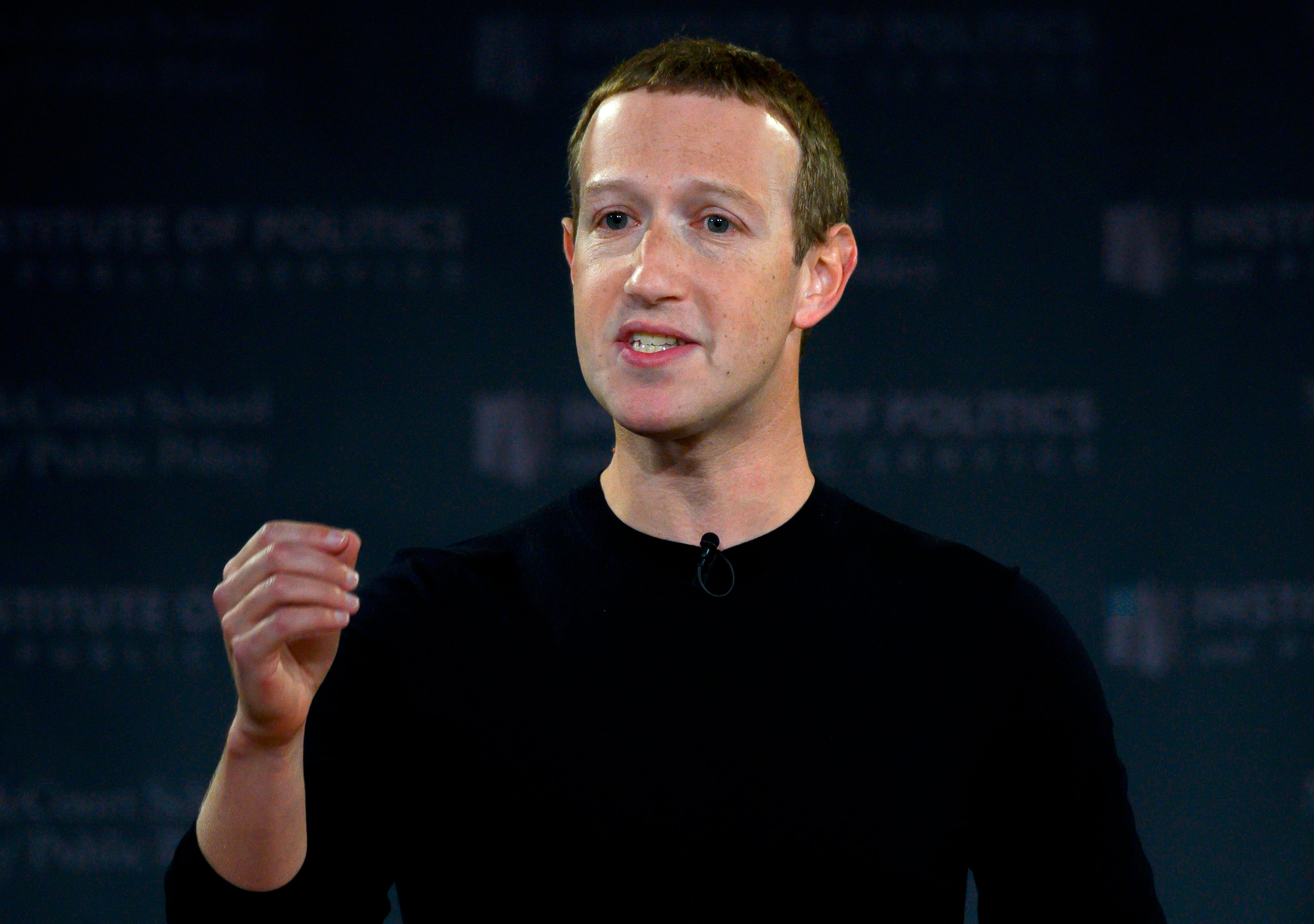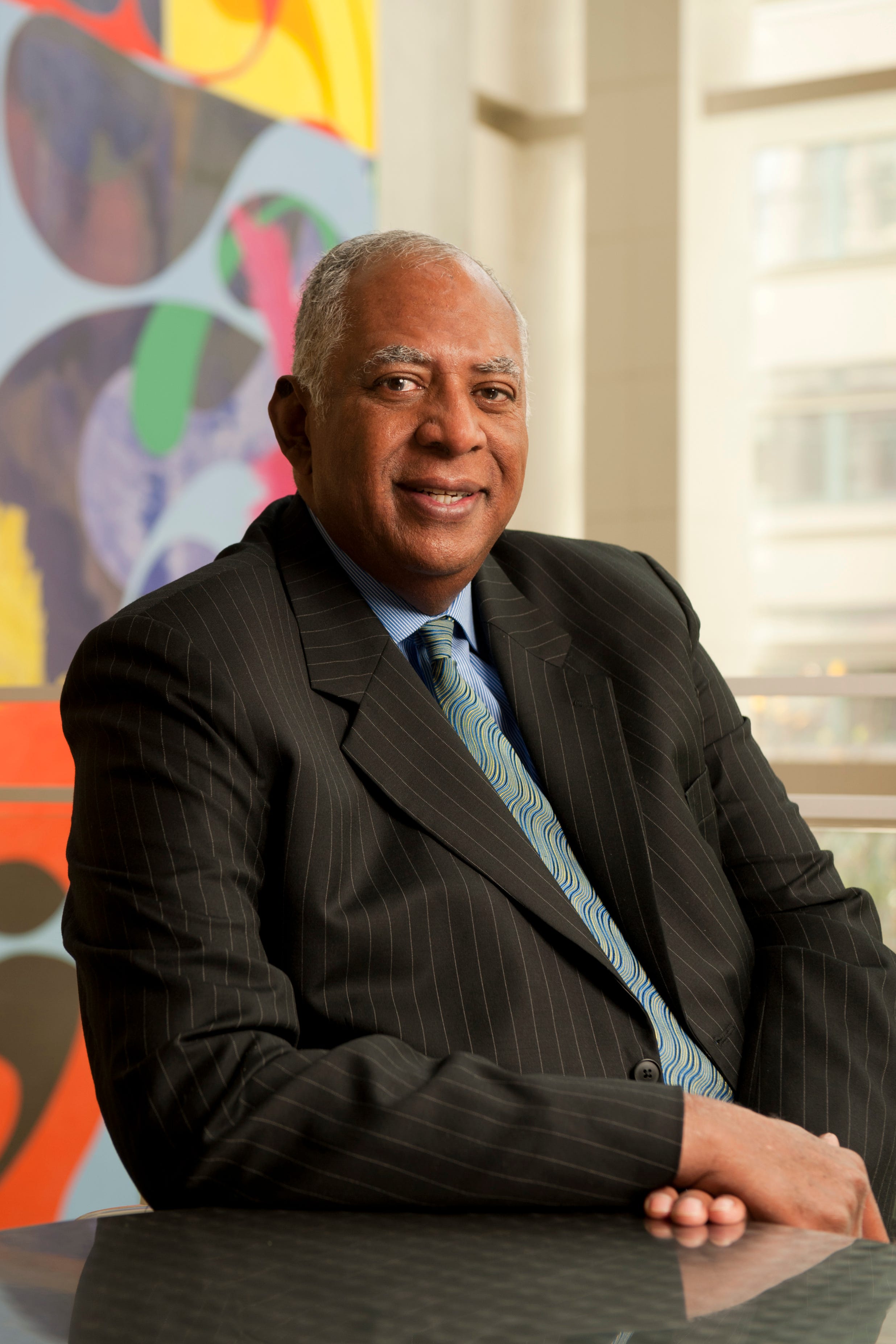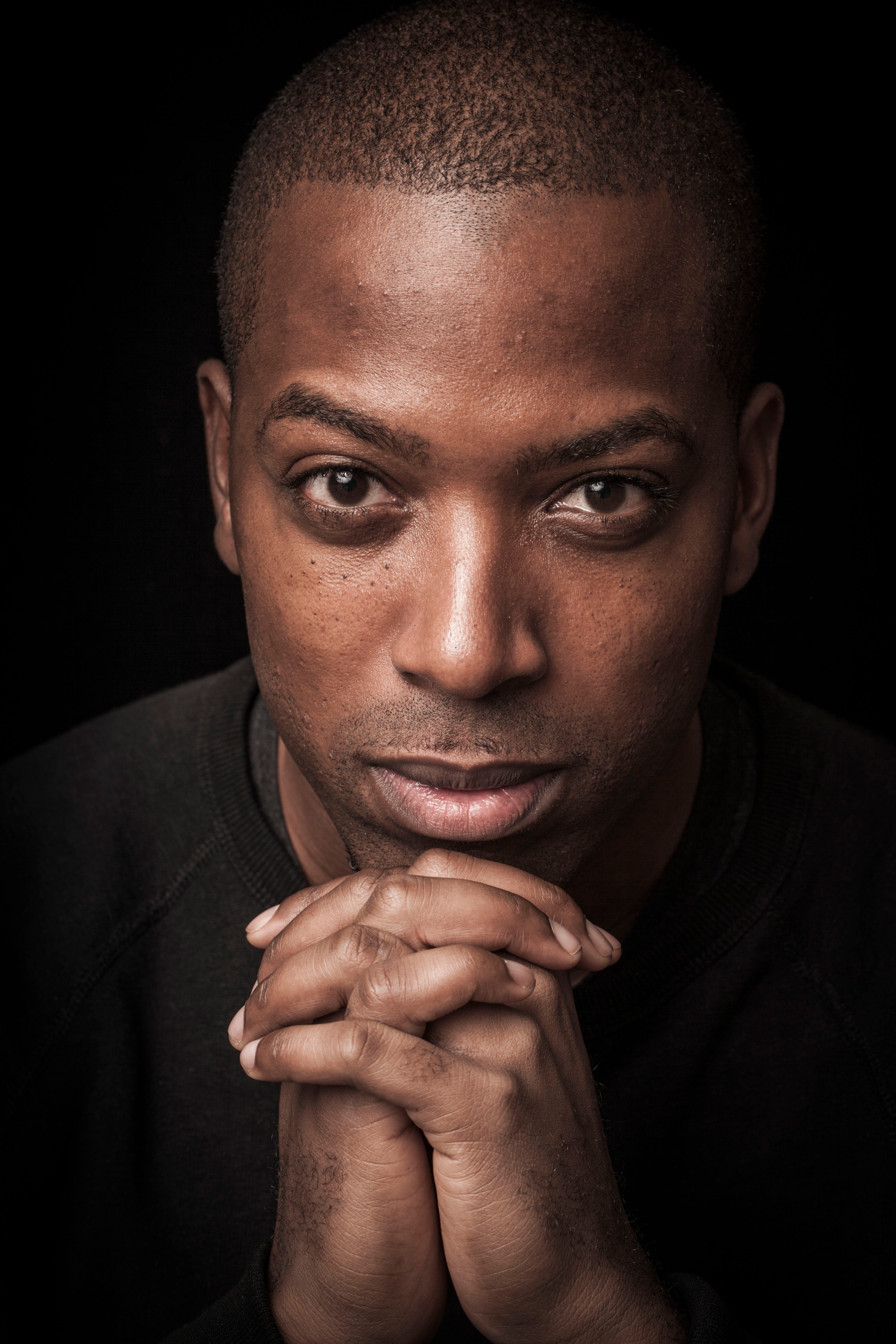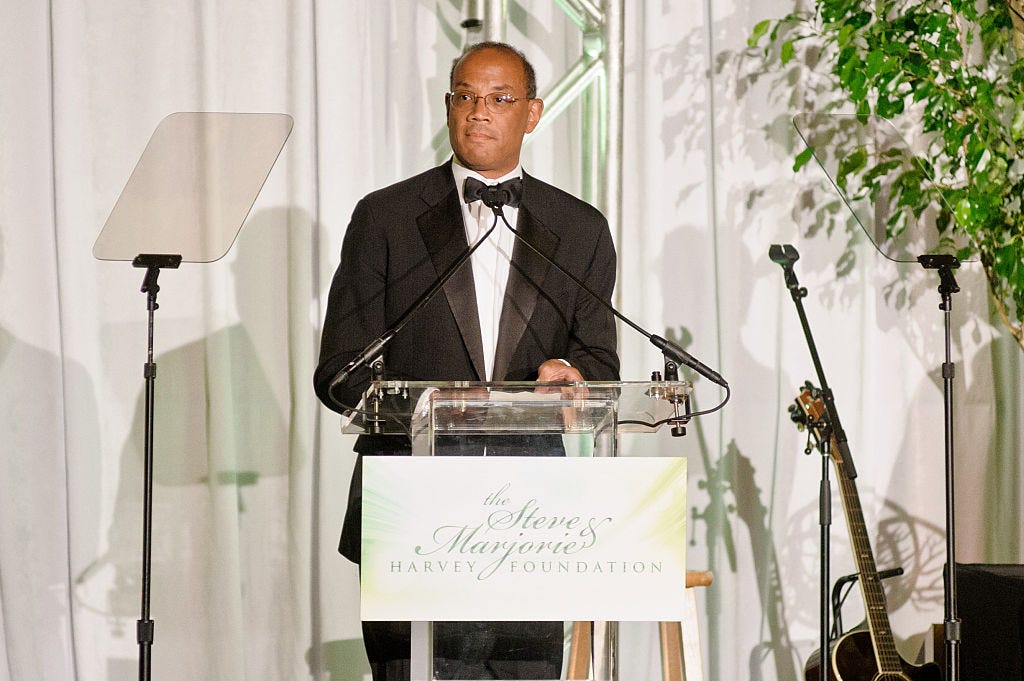
Editors' Note: Kenneth Frazier, the CEO of pharmaceutical giant Merck, announced on Feb. 4, 2021, that he plans to step down from his post this June. Frazier is Black.
Nike has been talking this talk for the past quarter century: Diversity, inclusion, equality.
The company's ads, which famously encouraged America to "Just Do It," have celebrated disabled athletes, female participation in sports and Colin Kaepernick, the outcast NFL player who protested racial injustice in 2016.
This year, after George Floyd, a Black man, died under the knee of a white policeman in Minneapolis, Nike announced a $40 million commitment to the Black community, declaring that it will "never stop striving to role model how a diverse company acts.” Nike even has three Black directors on its governing board of 12.
But all of those external signals stand in stark contrast to the complexion of the power players at the top of the company. All five of the top executive officers are white, a common reality in corporate America more than 55 years after the Civil Rights Act.
A USA TODAY analysis shows that while corporations and boardrooms have added African Americans over the decades, the executive suite has not, even at companies that have diverse boards.
Merck CEO to step down: Kenneth Frazier is leaving, becomes executive chairman
USA TODAY reviewed the most recent proxy statements for the 50 largest companies in the Standard & Poor's 100 as of July 15, including some of the world’s most influential consumer brands such as Apple and Facebook. These regulatory filings show compensation for the top executives, among other corporate matters, to help shareholders make informed decisions at stockholder meetings.
Nearly all – 48 – issued statements in support of the Black community following Floyd's death May 25, an unprecedented outpouring after decades of corporate silence on anti-Black racism and police killings in the United States.
Yet corporate America's top ranks look nothing like the country they serve. Of the 279 top executives listed in the proxy statements, only five, or 1.8%, were Black, including two who recently retired.
Many of these megacompanies are still led by all-white executives in the top five slots listed on proxy statements – the CEO, the chief financial officer and three other top-paid executives. In some cases, companies also list other top-paid officers who recently left. In all 279 listed executives appear on the 50 proxy statements examined by USA TODAY.
Business and diversity scholars say the executive suite is still one of America’s most exclusive and impenetrable clubs, with the corporate hierarchy most closely resembling a plantation: Heavily white at the top. Black labor struggling to move up.
For decades, corporate America has failed to hire, promote and fairly pay Black men and women, stalling many from rising above middle management, says Ella L.J. Bell Smith, Dartmouth professor of business administration.
This stark racial divide has a cascading effect, stagnating income levels and helping worsen the race, class and wealth gap that is yawning even wider during the COVID-19 pandemic.
It also puts corporations at a disadvantage. As the nation gets less white and more diverse, corporate America will need to adapt to better serve that changing market. A 2018 Boston Consulting Group study suggests that greater diversity on leadership teams improves financial performance and innovation. Even small changes to senior teams can generate gains, the study found.
Smith’s message to corporate America in 2020: Move beyond the hashtag activism.
“The reality is that we have to get past the talking,” said Smith, co-author of “Our Separate Ways," which examines the career trajectories of Black and white female managers. “How many times do you have to hear how women of color, men of color are being ostracized in your company? How many stories from Black folks do you need?"
“If you are still running a plantation internally, or if you are still running your company like the 1960s,” consider this your wake-up call, she said.
They spoke up about racial injustice. Now what?
On May 30, Netflix's corporate Twitter account tweeted: “To be silent is to be complicit. Black lives matter. We have a platform, and we have a duty to our Black members, employees, creators and talent to speak up.”
Co-CEO Reed Hastings and wife Patty Quillin also announced they were donating $120 million to historically Black colleges and universities to “reverse generations of inequity in our country.”
Netflix, which has one Black board member, or 8% of its board, also committed another $100 million to support Black communities in the U.S. But according to its most recent proxy statement, none of its top five executive officers is Black.
In a statement, Netflix told USA TODAY that in the past three years in the U.S., it has made strides, increasing the number of Black American vice presidents from three to nine and the percentage of Black executive-level managers from 0% to 13%.
Last month, Netflix hired prominent Black executive Bozoma Saint John as its chief marketing officer. Netflix’s website now shows her as the only member of its management team of eight who is not white.

The company executives page on Nike’s website recently went through its own makeover. The page had shown the photos of 10 people, all white, until mid-July when the photo line-up changed. It now shows an expanded photo line-up of 16, including three Black executives who had been with Nike since at least 2019 but were not previously listed on that page as top executives.
“The page was updated to reflect Nike’s current Executive Leadership Team,” the company said in a statement to USA TODAY, noting the recent promotion of two of those executives.
So why now? One of Nike’s board members, John W. Rogers Jr., said that Nike CEO John Donahoe has transformed his team after taking over in January.
“That’s real, not just a show (of faces),” said Rogers, who is Black.
Former Nike Brand President Trevor Edwards, who is Black, had been listed among Nike's top-paid elite leaders before he resigned in March 2018. Last year, 9.9% of its vice presidents were Black, according to Nike, which also recently announced a $100 million commitment to the Black community from Michael Jordan and Nike’s Jordan Brand.
Allegations about racial exclusivity at the top still have been an issue recently, including in an online letter June 1 from former Nike manager Danny Tawiah.
He wrote that “systemic racism exists within Nike” and that institutional racism curbs upward mobility for people of color.
“Nike, you have the power and the means to be the change that you promote in your seductive campaigns in support of the Black community, and it starts from within your own organization,” he wrote.
Nike, which had about 22% Black employees last year, said it continues to "sharpen our focus on hiring more Black leaders across all levels at the company."
In 2014, Apple made similar adjustments to its executive staff page online, adding photos of executives, including two Black women, soon after the release of a report that detailed the predominantly white and Asian male makeup of its workforce.
Six years later, the world’s most valuable company, has one Black board member and an all-white top-five executive tier, led by CEO Tim Cook, who announced a $100 million commitment to racial justice in June. Apple’s larger leadership team of 16 has one Black executive, according to its website. According to the company, 3% of Apple leadership is African American and it plans to take "significant new steps on diversity and inclusion."
"It’s one thing to add a Black member to your board or to promote at least one African American to the (executive suite) so you have numerical cover," Dick Parsons, senior adviser at asset management firm Providence Equity, told USA TODAY. "It’s another thing to understand why we need to do something extraordinary to get to where we need to be.”
Black executives losing ground?
When Parsons took the helm of Time Warner as CEO in 2002 and of Citigroup as chairman in 2009, he became one of the most powerful African Americans in corporate America.
“I thought this was the beginning of a wave of African American executives coming into the C-suite,” Parsons said.
The wave never crested. The problem is twofold, he says. Too few Black executives being groomed for key posts and too many corporations hunting for talent in all the same places.
At Time Warner, Parsons tapped one individual to make sure his company interviewed a diverse slate for every executive opening. More than 100 candidates from underrepresented groups were hired with no quotas.
“It turns out that to have a level playing field, you have to go out and search for candidates who can compete. And there is no shortage of minority candidates who can compete for these jobs,” Parsons said. “It’s not that they get overlooked. They don’t get looked period.”
Today, stubborn patterns of exclusion and discrimination are still keeping Black executives from reaching the top rungs despite the heights climbed by trailblazers such as former Xerox CEO Ursula Burns, the first Black woman CEO in the Fortune 500, and ex-American Express CEO Kenneth Chenault, who ran the credit card giant for 16 years.
If anything, the ranks of those who have occupied the corner office appear to be thinning. Last month, Jide Zeitlin stepped down as CEO of Tapestry, which owns the Coach and Kate Spade fashion brands, leaving four Black CEOs in the Fortune 500, none of them women, down from seven in 2014, according to Fortune Media.
By contrast, the boardrooms of these companies are becoming less homogeneous, with Black members making up about 11% of directors at the 50 companies in the USA TODAY analysis.
Leading business and diversity scholars warn against placing too much stock in Black representation on boards, which they say is too often window dressing to conceal the lack of diversity in the executive suite.
Board members who hail from a wide range of industries and backgrounds are appointed by the company and then voted on by the shareholders, but most senior leaders in corporate America come up through the ranks of the organization or from within the same industry, says Duke University's Ashleigh Shelby Rosette.
"Attaining a senior leadership role takes a much longer time to accomplish and the expertise needed to occupy the position is usually either company or industry-specific," said Rosette, professor and senior associate dean at the Fuqua School of Business. "More importantly, there exists so many more opportunities for biases and discrimination to creep in as one attempts the ascent up the ladder to a top position."

Facebook has pledged to employ 30% more Black people in leadership positions over the next five years. It also has added two Black members to its board since last year.
But Facebook lists all-white executives for the five it is required to name on its proxy statement. Its investor relations site lists an all-white management team of seven, including CEO Mark Zuckerberg and his lieutenant, Sheryl Sandberg. The company website lists an 18-member executive team with one Black member: Maxine Williams, the company’s chief diversity officer.
Similarly, at telecommunications company Verizon, a third of Verizon's nine board members are Black. On June 1, the company committed $10 million to aid organizations dedicated to "equality and social justice."
"Verizon is fiercely committed to diversity and inclusion across all spectrums because it makes us and the world better," Verizon Chairman and Chief Executive Officer Hans Vestberg said in a statement.

But none of the five top executives listed on the company's proxy statement is Black. On its website, Verizon lists 11 on its leadership team, one of whom is African American: Rose Stuckey Kirk, the chief corporate social responsibility officer.
Amazon, Microsoft, JPMorgan and Walmart also are among the companies that have a Black board member but no Black executive officers listed among their top five on their proxy statements. Bank of America, Pfizer and McDonald’s each have two Black board members but also list no Black executive officers. And some companies including Cisco and Oracle have no Black board members or executive officers listed.
Since July 30, two other companies that didn't have any Black board members or top executives listed on their proxy statements announced they were adding Black board members. Bristol Myers Squibb said it was expanding its board from 12 to 14 to add new board members Paula Price and Derica Rice, both of whom are Black. Procter & Gamble announced last week the appointment of new board member Debra Lee, the former CEO of BET Networks.
At the big five tech companies last year – Amazon, Apple, Facebook, Google owner Alphabet and Microsoft – there was only one Black executive listed on proxy statements. That executive, David Drummond, left Alphabet in January, according to the company's proxy statement.
Change has to come from the top

Why does it matter? Unlike the part-time boards of directors that oversee and advise the company leadership, top executives of these businesses are the captains of industry running the economy full-time and making decisions about the ways we communicate and shop, how our banks are run and what kind of information and entertainment we see online.
They are also the only ones who can lead the charge for racial equity, says Marvin Owens Jr., senior director of economic programs for the NAACP.
Diversity, inclusion and equity efforts inside major corporations are too often relegated to the sidelines, with few if any penalties for missing objectives, unlike other business initiatives, he said.
“If a CEO does not value diversity, if there is no accountability, there will be no meeting of internal goals and there will be no change,” Owens said.
It’s not that corporate America is lacking for Black executive talent, says Barry Lawson Williams, a retired Black businessman who has served on more than a dozen public company boards.
To live up to all those statements since May 25, he said companies must network outside their comfort zone.
“There is no issue, zero issue, with the candidate pool,” said Williams, founder of Williams Pacific Ventures, an investment and consulting firm. “The issue is they don’t know ’em, and they don’t have a vehicle to get comfortable with people in the candidate pool.”

Tristan Walker's phone has been ringing a lot lately. Corporations are hunting for Black executives to serve on boards of directors and for recommendations for top openings.
The 35-year-old founder and CEO of Walker & Co. Brands says he's grateful for progress. His majority-minority-led company makes a modern personal care line for people of color and merged with Procter & Gamble in 2018.
“I have seen people taking a stand and at least taking a side. It’s hopeful for me. But hope is not a strategy,” said Walker, who joined the board of Foot Locker in January and the board of Shake Shack in June. “What matters is sustained action.”
Rogers, the Nike board member, has heard this kind of talk before, too. Companies say they want to be less white at the very top but don’t follow through to make it happen.
So what is he supposed to do as a Black businessman who has served as a member of several companies’ boardrooms?
“What I’ve learned is if I’m on a board and they’re not interested in fairness and true economic inclusion, then I will resign from that board,” said Rogers, founder and CEO of Ariel Investments, who sits on the boards of directors of Nike and McDonald’s. He declined to name the companies he's left. “I’ve done that several times over the years, where this is not a good fit, and these people are not living the values they say they believe in.”

One snapshot of the racial stratification in private industry can be seen in the ratio of those at the top compared with those at the bottom.
For white people, the ratio of service workers and laborers compared with senior-level management is roughly 7 to 1, according to 2018 statistics compiled by the U.S. Equal Employment Opportunity Commission. For Black people, that ratio is 105 to 1.

Black people make up 13.4% of the population. But they only represent 8% of white-collar professionals, a number that has stayed steady since 2013, according to a study by the Center for Talent Innovation, a nonprofit research group.
“It helps to explain why the wealth gap in this country has gotten so much worse in the last 40 years,” Rogers said.
Improving diversity at the top of the ladder “makes our country stronger” and provides role models for the next generation, he said. “People see them and want to be them.”
Leandrew Robinson's first start-up was a hot dog stand in a church parking lot when he was 11. He ran a T-shirt company in college. In 2015, he co-founded Hingeto, a platform to create and sell branded products such as Marshawn Lynch’s Beast Mode and mall retailer PacSun.
When his venture capital-backed company hit hard times, Robinson, 37, went without a salary to keep Hingeto afloat long enough to sell it. Now he’s been recruited to run a new business unit at ShipStation, which is owned by Stamps.com, to help small e-commerce businesses during and after COVID-19.
The success of Tristan Walker and other Black entrepreneurs and executives in the tech world helped propel Robinson.
“When you see someone who looks like you and who speaks like you, it’s almost like this superpower that encourages you to reach similar heights,” he said.
Lack of leadership diversity is 'pathetic'
But how to break through the Black ceiling? The lone Black CEO among the top 50 companies reviewed by USA TODAY is Kenneth Frazier of Merck, the pharmaceutical giant. In his view, the absence of African Americans in corner offices is “pathetic.”
“Just look at the leadership teams,” Frazier said in a July interview with Harvard Business School professor Tsedal Neeley.
In the early 1990s, Frazier was plucked from his law practice in Philadelphia by one of his predecessors, Roy Vagelos, who had grown frustrated that he couldn’t get his colleagues to promote African Americans.
Today, Frazier, 65, also is chairman of Merck’s board of directors and is one of two Black people to sit on the board of ExxonMobil, another top-50 company with all-white leadership among five top executives listed on its proxy statement.
Thirty percent of Frazier’s senior team is African American. But even on his watch, progress is elusive. Very few African Americans make it within striking distance of the executive suite, two or three salary grades below Frazier’s senior team. He said he’s called on his team to come up with a plan to advance African Americans and will tie their compensation to results.
“We have to be willing to take the position that, if we're not racist, we need to challenge a process, a system, a custom that allows African Americans to advance, not at the same rate as everybody else,” Frazier said in the Harvard interview. A company representative declined to make Frazier available for an interview with USA TODAY.
“At the end of the day, if you're complacent with the status quo, you're complicit in the racism that the status quo hides,” Frazier said.
Some corporations reacted to Floyd’s death in May by setting public goals and timetables. For example, Microsoft CEO Satya Nadella says he plans to tie the promotion of senior executives to their diversity efforts.

Technology company Cisco has no Black members on its board of directors or among its six executive officers, according to its website this week. It recently set goals to increase the representation of Black employees at all levels of the company.
Cisco said that means a “25% increase in representation of Black employees from entry-level through manager level and a 75% increase in representation of Black employees from director to vice president+ by 2023.”
“Nobody should be able to look at a man being killed on camera because someone is kneeling on his neck as an agent of the state and not be moved by that,” said Adia Harvey Wingfield, sociology professor at Washington University in St. Louis whose research focuses on racial and gender inequality in professional occupations.
But, she says, it's a lot easier to black out your Instagram profile for a day than to look inward, "particularly when many of the people at the top of these workforces are white men who haven’t had to wrestle with these issues and haven’t, as we know from history, been motivated to do the difficult work of really trying to change these issues.”
Parsons says he's old enough to "have been at this place before" in the late 1960s and early 1970s. “You could have literally taken the headlines from those days and moved them forward 50 years to George Floyd and that reaction,” he said.
What he does not want to see are the same headlines a half-century from now.
“What we have a tendency to do in business, in particular, is throw money at a problem. Money is important but it’s not going to solve this problem all alone. We have to look at how the structure of our economy works and make changes. That’s the next step. And that’s going to be hard," he said. "As a practical matter, it means taking from those who have privilege, privilege that they are sometimes not even aware of, and giving to those who have not had that privilege, who truly are on an unequal footing. That’s much tougher than just giving money."
Follow reporter Jessica Guynn @jguynn. Email: jguynn@usatoday.com
Follow reporter Brent Schrotenboer @Schrotenboer. E-mail: bschrotenb@usatoday.com